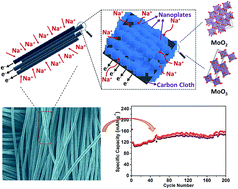Flexible electrode for long-life rechargeable sodium-ion batteries: effect of oxygen vacancy in MoO3−x
Abstract
Layered molybdenum trioxide (MoO3) has rarely been studied as an electrode material for sodium ion batteries due to its low electronic conductivity and irreversible phase transitions. Here we demonstrate that MoO3−x, with a well-controlled oxygen vacancy, exhibits near theoretical capacity, excellent rate capability, and 2000 stable cycles with minimal capacity loss. The oxygen vacancy in MoO3−x is responsible for the two-plateau voltage profile, in contrast to the sloping feature observed in α-MoO3. This work highlights the importance of oxygen vacancies in enabling long-life rechargeable sodium-ion batteries.



 Please wait while we load your content...
Please wait while we load your content...